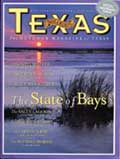
At Issue
From the pen of Robert L. Cook
Although many Texans take it for granted that we’ll always have plenty of fresh water, water rationing is a real possibility in our future. If we want to avoid that unpleasant task, we must do a better job of water planning and water conservation. We can provide an adequate supply of fresh water for future Texans if, and only if, we act now. We need to take action promptly and make these decisions while our options are still open. We should not wait until the crisis is upon us and all the choices are bad. Ask California, Florida and a double handful of nations around the world about dealing with these issues during a water crisis.
Texas has the water-planning framework to take us into the future. In 1985, the 69th Texas Legislature provided that environmental needs be considered in issuing new water permits, and directed TPWD and the Texas Water Development Board to come up with the science to do so. In 1997, the 75th legislature adopted a regional approach to water planning and management under the requirements of Senate Bill 1.
We now have the science that tells us how much water we need in our rivers and lakes, and how much water needs to flow into our bays and estuaries so that they will remain healthy and productive. We have the tools to balance the water equation and meet our human, economic and ecological needs. We must decide how to use those tools and, in true Texas style, we have to get it done.
Urban and rural Texans can help balance our water equation through water conservation and good land management. Rural landowners can make significant contributions through good range management and brush control to increase absorption of rainfall, reduce erosion, restore spring flow and improve water quality, thereby assuring clear-running streams and rivers. Urban Texans must take action by installing low-flow shower heads and toilets, by doing larger loads of laundry, by using less water to wash the car and by reducing or eliminating the need to water the lawn by planting native grasses adapted to our state’s normal rainfall rates.
The key issue is what we do with the water we save from these efforts as well as with the water now in our rivers that is not appropriated for other uses. Following the lead of other western states, Texas should carefully consider implementing a water reservation system for instream flows and freshwater inflows. Under a reservation system, the state could reserve from permit appropriation enough instream flow of fresh water to maintain the health and productivity of our rivers, lakes, bays and estuaries. In order to accomplish this goal, a public process, incorporating all essential stakeholders and relying on the best available technical information, can be developed to determine the reservation levels needed for each of our state’s legendary river systems.

